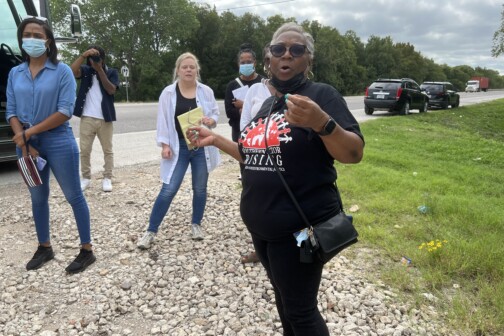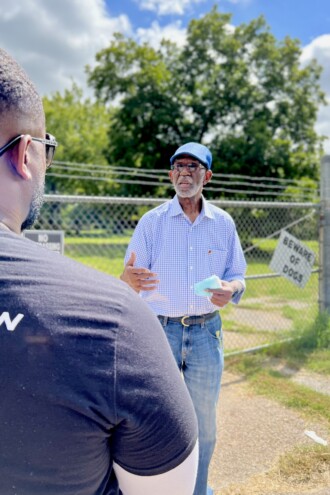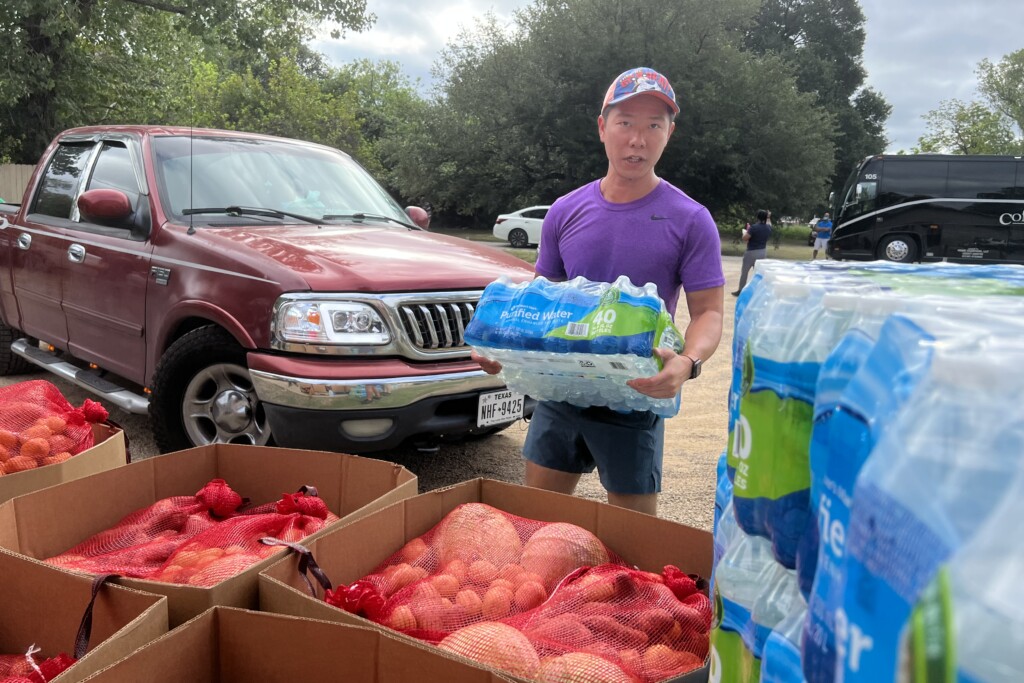The line of cars queued to pull into the parking lot of Mount Zion Baptist Church in Sand Branch on Saturday snaked down Burns Drive and around the corner to Beltline Road. Volunteers called out numbers—“2!” or “3!”—to tell runners how many cases of water to put in the trunk of each vehicle as it pulled forward. A group of people on an environmental justice bus tour led by Southern Sector Rising and environmental nonprofit Taproot Earth were temporarily pressed into service in a bid to move cars out faster.
“If you can tell people anything,” a volunteer said, “tell them that we need help. We need help every Saturday, but these people also need drinking water in their homes.”
The community sits in unincorporated land in Dallas County near Seagoville, about 20 miles south of downtown Dallas. It has been decades since it had running water. Sand Branch is a freedman’s town was established in the 1800s, and until the 1980s residents received water through wells dug throughout the community. Without access to a sewage system—despite being so close to the Dallas Southside Wastewater Treatment plant that they can smell it—residents rely on septic tanks.
In the mid-’80s, residents began to worry that the water coming from those wells was making people sick. Dallas County tested it, and found that it had been contaminated with E.coli. Since then, there have been numerous efforts to bring water permanently to the area, but so far, none have come to fruition. That’s partly because of a 2003 Federal Emergency Management Agency ruling that found the area was in violation of county floodplain regulations.
In 1985, Dixie and Albert Turner talked to the writer Richard West about their community for a story in D Magazine. At one time, the area was lush and green, with gardens, creeks, and hay grass. The Turners were able to open a general store in 1959, and kept it as a going concern for quite some time.
“It was before electricity,” says Dixie Turner. “We used kerosene lamps and had a hand pump that gave us the coldest, best-tasting water I ever had. Now we bring our drinking water in milk jugs from our place on Cedar Creek.”
Those on Saturday’s tour asked volunteers and residents when the trouble with the water started. As a testament to how much time has passed, nobody at Mount Zion could recall the exact time when it started making people sick. The issue is now nearly old enough (if it were a person) to need to schedule a mammogram. In 2000, 400 people lived there. More recent estimates say maybe 100 people live in Sand Branch, and nearly all of them line up on Saturdays to get water and groceries at Mt. Zion.
Saturday’s bus tour had several more stops along its 63-mile route, all selected by Floral Farms resident and Southern Sector Rising leader Marsha Jackson. She acted as a co-docent of sorts with community member Allen McGill. The charter bus visited Sand Branch, Floral Farms and the former site of Shingle Mountain, the GAF shingle factory in West Dallas, Joppa, the Lane Plating site, and the McCommas Bluff landfill.

“I need to see doctors for things I never have had to before,” Jackson told the group as she stood next to the site that was once home to Shingle Mountain. While a great deal of Floral Farms is zoned for commercial or industrial use, Jackson and her neighbors live on land that is zoned for agricultural use. The city has begun the process for an authorized hearing to examine the zoning for the area, which could affect the proximity of industry to homes.
Just 5 miles south of downtown, Lane Plating operated for almost a century. It was shuttered when the company declared bankruptcy after state and federal officials closed in, having made a case that it was negligently disposing of the hazardous waste it produced. It is now an EPA Superfund site, but has been awaiting demolition for several years.
Joppa, settled in the late 1860s by formerly enslaved people of the nearby Miller plantation, is one of the few remaining Freedman communities in Texas. It also recently had to wait weeks for cleanup from a train derailment. West Dallas is currently grappling with the exit of the GAF shingle factory and a proliferation of concrete batch plants, but is also dealing with the aftermath of asbestos contamination from a long-closed vermiculite processing plant. It also engaged in a lengthy and ultimately successful fight to remove a lead smelter from the area in the 1990s.

McGill and Jackson wrapped up the tour with a nod to the efforts that have been started to help each of the communities the group visited—only to falter or drop off as enthusiasm waned.
“Those folks who said they were with us, they don’t understand this concept, or worse, they know what the concept of equity is and duck,” McGill said. “I have no patience for those kind of folk. This is hard work.”
A visibly emotional Jackson referred to the plight of the residents of Sand Branch, where she has friends. “It bothers me, it tears me up, a community that has to continue living like that. How we feel today? Just imagine how somebody is living every day without water. That’s their property. That’s their home.”
Both Jackson and McGill called out groups and elected officials who are vocal in their desire to see equity in Dallas. But until you can turn on a tap in Sand Branch and get clean water, or be completely sure that the creek behind family homes is free of hazardous waste, it becomes clear how far we have to go.
Get the D Brief Newsletter
Author





